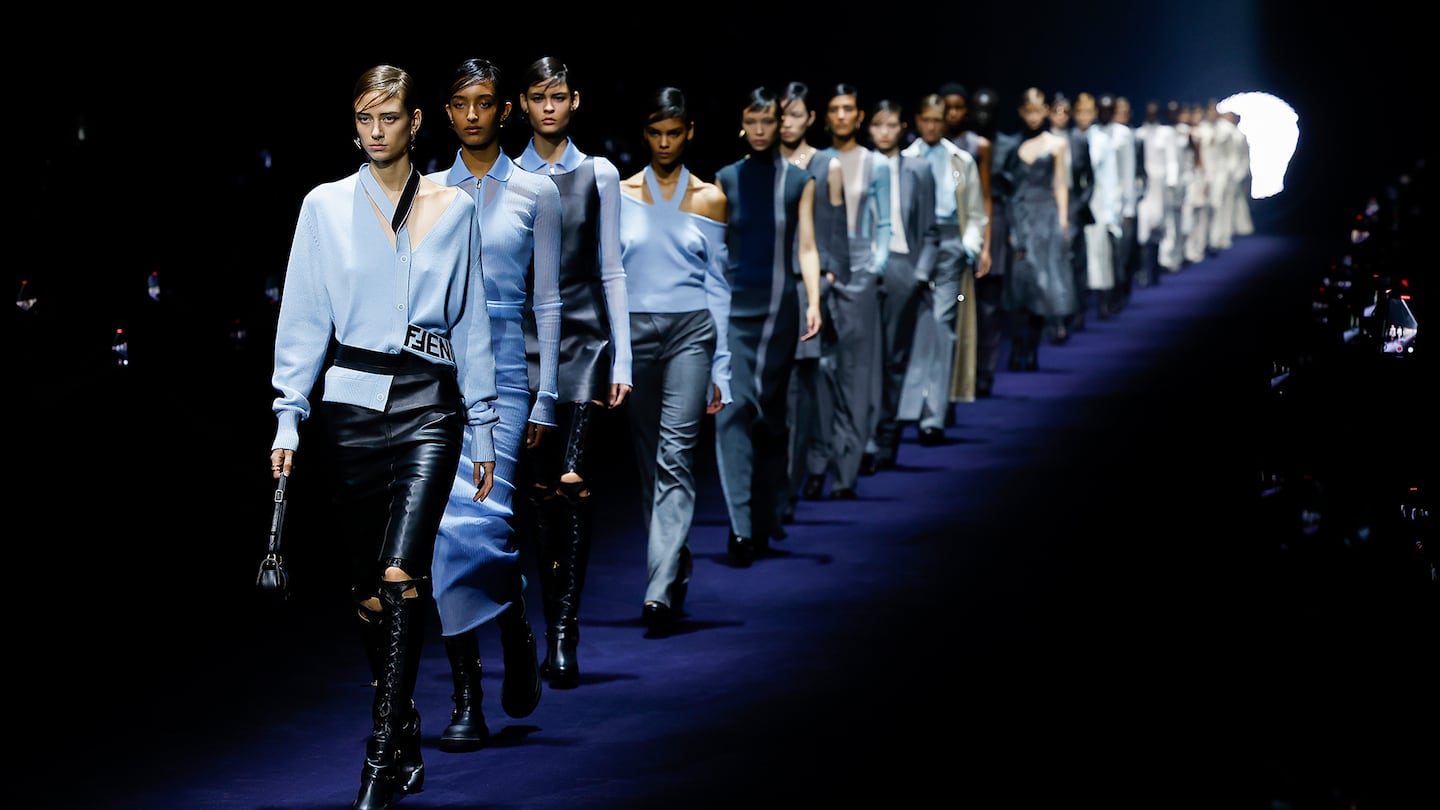
The Business of Fashion
Agenda-setting intelligence, analysis and advice for the global fashion community.

Agenda-setting intelligence, analysis and advice for the global fashion community.

MILAN — Imagine you’re a fashion designer who’s just been handed an iconic brand to remake/remodel for a challenging future. The road behind is littered with the bruised reputations of the many who’ve folded at the challenge. The road ahead? Well, you could take a good look at the first day of Milan’s show season for Autumn/Winter 2023 to see how your peers are strategising, and take it from there.
It’s exactly two years since Kim Jones showed his first ready-to-wear collection for Fendi. In that time, he’s evolved a different approach to his protean predecessor Karl Lagerfeld, tuning into a calmer, more subtle expression of Roman sophistication. “I know it sounds repetitive,” he said, as he insisted once more that he’s inspired by the wardrobe of Delfina Delettrez Fendi, which she has plucked from the closets of her mother Silvia Venturini Fendi. But I guess there’s nothing like going straight to the source, especially when it yields a colour palette as striking as this new collection’s shades of pale blue and bitter chocolate, an unlikely but cool combination. Also reflective of the Fendi women: the knitwear, and the menswear-iness of the tailored coats and trousers. “Looking at the sophisticated Fendi woman in quite a simple way,” was how Jones put it.
0 of 51
He’s a canny one. The women’s collections Silvia Venturini Fendi designed on her own before he started work for the house gave him invaluable insights into what she identified as Fendi’s signatures. First and foremost, there was a bourgeois-with-a-twist element. That dovetailed with Lagerfeld’s sensibility, so there was always a perverse subtext somewhere in the collections, for both women and men. You could see Jones nodding to that with his first look, a pale blue cardigan paired with a black leather skirt and boots that brought to mind the dominatrix looks designed by Lagerfeld for the 1975 movie “Maîtresse.” Silvia referred to them in her Autumn/Winter 2020 collection. Maybe Jones was picking up on them now, the same way he also picked up on the languor of the last collection Silvia was responsible for before he came on board. The lean elongation of his knit dresses was emphasised by a single stripe, stem to stern, recalled from Fendi via Lagerfeld circa 1996.
Jones himself is also quite partial to a perverse subtext. Here, there were second-skin tops that duplicated in micro-pleated silk an ultra-acrylic top that Vivienne Westwood designed for Let it Rock, her first shop in 1971. “I’m probably the only person that’s got that,” beamed collector Kim. Westwood has obviously been on everyone’s minds of late, but Jones claimed he never stops thinking about her. Which made me wonder about the kilts clipped over pants in this collection. That was the look that garbed the most gorgeous manifestations of Westwood’s warrior punks in the heyday of her King’s Road mecca Seditionaries.
ADVERTISEMENT
But Fendi has also borne Jones into the upper echelons of haute couture, which has added new words to his fashion vocabulary. Lace, for instance, manifest here in a tablecloth skirt or a camisole attached as a boudoir-ish flourish to the front of a prim blue poplin blouse (I’d call that borderline perverse). And sequins, subtly lining those menswear-ish coats, so suggestive of a secret life.
The soundtrack was Julee Cruise’s “Falling,” soundtrack of that secret life. The set was a futuristic tunnel of light. Jones knows how to create a mood, an atmosphere of mystery almost. But it might be time for him to push the limits of the world he’s created at Fendi. I don’t imagine Silvia would complain.
Still, as Glenn Martens said yesterday, “Every smart creative director goes back to the founding values of the brand.” But he’s had a very different set of values to work with at Diesel. Company founder Renzo Rosso is “the Leonardo da Vinci of broken denim.” Or so he tells Martens every day (according to Martens). In the 1980s, Diesel industrialised distressed denim. In the two years he’s been in charge, Martens has changed the formula so aggressively — and been given the money to promote that change with big campaigns and shows — that there is a generation (let’s call it Z) who are discovering Diesel as SOMETHING NEW! just for them. An open-minded, free-spirited, sustainability-veering democracy of style. Which is why we walked into a massive exhibition space in Milan to be met by a mountain of Durex boxes, 200,000 in all, an appetiser for the 500,000 condoms Diesel will be distributing for free through their global network in April. “Successful Living” is the brand’s tag line. “And what’s more successful that being free with your body, your spirit and other people?” was the question Martens posed.
0 of 72
For the purposes of the show, “Successul Living” became “Sucsexful Living”. On the soundtrack, Barbarella’s orgasmatron was cranked up to 11. Go ahead, have fun, respect each other, be safe. Hence the mountain of condoms. “The brand was initially a bit stressed,” Martens added, “but now they understand it’s not an egocentric point of view. The brand is talking to kids and you have to do this kind of thing to talk to a new generation.”
But his primary means of communication is obviously the collection. When Martens talked about it “lifting you up in a sensual, sexual way, not an intellectual way,” the proof was right before us, parading around Mt Condom. The Diesel ethos is biker denim distressed to the brink of dystopia, but Martens has found a way to infuse it with alien beauty, weaving denim with polyester organza in a devoré effect that he is trying to patent. Limbs and torsos glimpsed through sheer patches in jackets, jeans, skirts and evening sheathes generated a subtle erotic undertow. The implication of revelation was carried into double-layered jersey pieces (the top layer distressed to reveal the second skin colour beneath) or the way a single metallic D (for Diesel) choker held a black jersey gown in place at one model’s throat. Delicate traceries of draped chain performed a similar function for other equally dressy looks.
The suggestion of fragility in these outfits created a radical contrast with biker denims metallised and oxidised until they were practically armoured. It’s not a new technology, Martens explained, because it’s used in producing cars, but this was the first time it had been applied to clothes. And even that paled beside the collection’s artisanal grouping, all of it made from upcycled materials. Deadstock nylon was once coat linings, now it was covered with plastic and heated until it melted into a mess that made a new coat. Deadstock faux fur was painted, also covered with plastic and heated until it created a psychedelic effect Martens called “liquid fur.” And technical biker jackets were assaulted with a blowtorch until they crinkled and cracked into a hybrid new form. The intensity of the handwork involved in these pieces surely qualified them as a new kind of couture, grotesque but eerily gorgeous. Somewhere in the ether, Alexander McQueen was roaring his approval.
I wonder what Roberto Cavalli was roaring after Fausto Puglisi’s show on Wednesday night. Where Jones is respectful about his custodianship and Martens is anarchic, Puglisi simply channeled Cavalli so successfully that it was as though no time had passed since Roberto himself last scored a catwalk triumph, a good decade at least since he quipped, “Excess is my success.” Mariacarla Boscono walked in Cavalli’s 40th anniversary show 13 years ago. She closed Puglisi’s show on Wednesday. Now that’s continuity.
0 of 54
Puglisi’s been spending a lot of time in LA, where he does a lot of business. He felt that had helped tune him back into Cavalli’s past, not just his Hollywood fan club, but also his start in fashion, creating artisanal jeans for the proto-jet set in Ibiza in the 1960s. So Puglisi offered sinuous, sheer red carpet fantasias, alongside the rock-chickability of bedazzled denims. But he also claimed inspiration from a couple of icons of Americana: the legendary couture client Millicent Rogers (muse for Christian Dior and Gianni Versace) and the artist Georgia O’Keeffe, both of them residents of New Mexico, which encouraged a palette of sand and earth and desert sky, cowgirl leather patchworks and the occasional outcrop of turquoise.
It was truly excessive — the pelmet skirts, the bared midriffs, the thigh high slits, the micro this and maxi that — but excess was also its success, just as Cavalli predicted, as a fantastic blast from the past for anyone who ever relished (however guiltily) one of Roberto’s orgiastic presentations. And actress Bella Thorne, far too young to remember such prelapsarian moments, insisted it was just what her friends had been waiting for.
But his celebration of tradition isn’t all that it seems.
Casey Cadwallader and Pieter Mulier prove that iconic design signatures can be rewritten for a new age.
Pierpaolo Piccioli at Valentino and Kim Jones at Fendi have very different visions for Rome’s most famous fashion houses
Glenn Martens speaks exclusively to Tim Blanks about re-energising the Italian denim brand, designing for his own label Y/Project and pushing people to rethink fashion.

Tim Blanks is Editor-at-Large at The Business of Fashion. He is based in London and covers designers, fashion weeks and fashion’s creative class.
From where aspirational customers are spending to Kering’s challenges and Richemont’s fashion revival, BoF’s editor-in-chief shares key takeaways from conversations with industry insiders in London, Milan and Paris.
BoF editor-at-large Tim Blanks and Imran Amed, BoF founder and editor-in-chief, look back at the key moments of fashion month, from Seán McGirr’s debut at Alexander McQueen to Chemena Kamali’s first collection for Chloé.
Anthony Vaccarello staged a surprise show to launch a collection of gorgeously languid men’s tailoring, writes Tim Blanks.
BoF’s editors pick the best shows of the Autumn/Winter 2024 season.